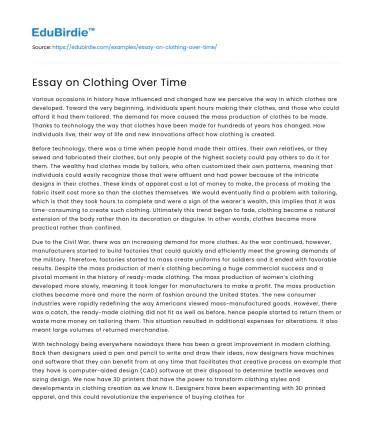Various occasions in history have influenced and changed how we perceive the way in which clothes are developed. Toward the very beginning, individuals spent hours making their clothes, and those who could afford it had them tailored. The demand for more caused the mass production of clothes to be made. Thanks to technology the way that clothes have been made for hundreds of years has changed. How individuals live, their way of life and new innovations affect how clothing is created.
Before technology, there was a time when people hand made their attires. Their own relatives, or they sewed and fabricated their clothes, but only people of the highest society could pay others to do it for them. The wealthy had clothes made by tailors, who often customized their own patterns, meaning that individuals could easily recognize those that were affluent and had power because of the intricate designs in their clothes. These kinds of apparel cost a lot of money to make, the process of making the fabric itself cost more so than the clothes themselves. We would eventually find a problem with tailoring, which is that they took hours to complete and were a sign of the wearer’s wealth, this implies that it was time-consuming to create such clothing. Ultimately this trend began to fade, clothing became a natural extension of the body rather than its decoration or disguise. In other words, clothes became more practical rather than confined.
Save your time!
We can take care of your essay
- Proper editing and formatting
- Free revision, title page, and bibliography
- Flexible prices and money-back guarantee
Due to the Civil War, there was an increasing demand for more clothes. As the war continued, however, manufacturers started to build factories that could quickly and efficiently meet the growing demands of the military. Therefore, factories started to mass create uniforms for soldiers and it ended with favorable results. Despite the mass production of men's clothing becoming a huge commercial success and a pivotal moment in the history of ready-made clothing. The mass production of women’s clothing developed more slowly, meaning it took longer for manufacturers to make a profit. The mass production clothes became more and more the norm of fashion around the United States. The new consumer industries were rapidly redefining the way Americans viewed mass-manufactured goods. However, there was a catch, the ready-made clothing did not fit as well as before, hence people started to return them or waste more money on tailoring them. This situation resulted in additional expenses for alterations. It also meant large volumes of returned merchandise.
With technology being everywhere nowadays there has been a great improvement in modern clothing. Back then designers used a pen and pencil to write and draw their ideas, now designers have machines and software that they can benefit from at any time that facilitates that creative process an example that they have is computer-aided design (CAD) software at their disposal to determine textile weaves and sizing design. We now have 3D printers that have the power to transform clothing styles and developments in clothing creation as we know it. Designers have been experimenting with 3D printed apparel, and this could revolutionize the experience of buying clothes for the average consume and it will allow consumers to print out objects like bracelets in a matter of minutes from the comfort of their homes, which indicates that fashion is always evolving, and we are finding new ways every day to keep up with an ever-changing culture.
Clothing styles and the way we create our daily attire have been greatly affected by our history, culture and new developments in technology. Garments started to be man-made then with machines it helped mass-produced clothes but since then, technology has helped further develop it into an extraordinary process. Dress styles and improvements in apparel creation have gone through many phases over the years and is still changing.






 Stuck on your essay?
Stuck on your essay?

